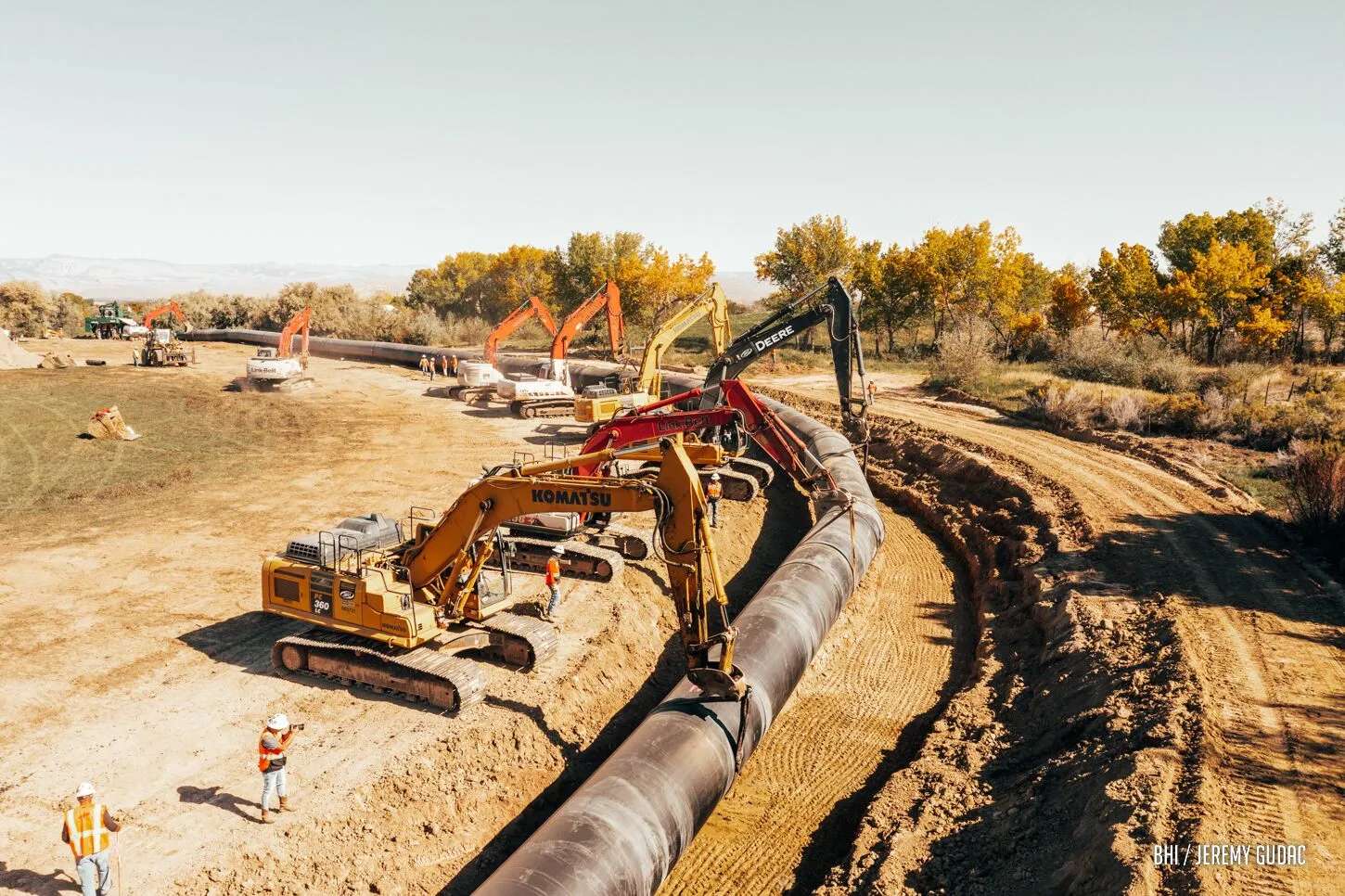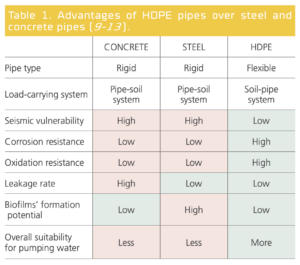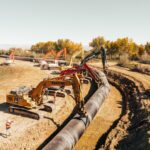This case study outlines using solid-walled HDPE pressure pipes for canal enclosures to support long-term water conservation efforts.
Context
Steinaker Service Canal is approximately 61,950 feet long and runs from the outlet works of Steinaker Reservoir about 12 miles south. It was constructed as an earthen, unlined open channel in 1961 by the U.S. Bureau of Reclamation and is operated and maintained by the Uintah Water Conservancy District (UWCD).
The canal typically carries 120 cubic feet per second (cfs) of irrigation water to users in the Ashley Valley area, delivered through 34 active turnouts.
Irrigation is one of the most demanding uses of water worldwide. A Utah geological survey has reported that about 33% (other estimates as high as 42%) of the United States water use goes toward irrigation activities such as crop production and recreational lands (1). In 2018 alone, there were about 55.9 million acres of irrigated land in the United States (2).
Surface water is the primary withdrawal source for irrigation in the United States. Canals are the preferred method of transporting this water due to their cost efficiency across long distances (3). However, the major drawback of open canals is direct contact with the surrounding environment, resulting in multiple problems such as water evaporation and seepage loss (4).
While a canal lining solution is typically adopted to limit seepage loss, it lacks control over water evaporation (5). UWCD is developing the Vernal Unit Efficiency Project (VUEP) that would enclose the entire canal in a pressurized conduit from Steinaker Reservoir to its end and offer a long-term solution to address water evaporation and seepage loss.

Opportunities
Canal enclosures have gained recognition as an effective method to help reduce water loss. By enclosing the canal with a pipe, the waterway retains all the benefits of an irrigation system while increasing savings through improved water retention.
Canal enclosures can also address public safety concerns associated with open canals in urbanized areas by improving water quality, eliminating contamination from external sources, providing redundancy for drinking water supplies, and allowing for the development of recreational projects near the enclosed canal (6–8).
Pipeline material selection is among the most critical factors that affect the performance and success of any canal enclosure project (6). Various design considerations must be addressed when selecting the appropriate pipe material, including the pipe type, load-carrying system, corrosion protection, leakage rate, and pressure requirements. Additionally, for the Steinaker Service Canal, special consideration was required to address bends along the canal.

Solution
Bowen Collins & Associates, Inc., the project’s engineers, turned to a high-density polyethylene (HDPE) piping system to enclose the canal. HDPE pipes offer corrosion resistance, flexibility, durability, and lower seismic susceptibility than other piping materials such as concrete or steel. Moreover, it provides a zero-leakage rate and low biofilm formation potential, highlighting its capability to preserve water quality while transporting it.
To support the project, AGRU America manufactured 15,500 ft of OD 2 m SDR 26 HDPE pipe and imported HDPE fittings from its parent company in Austria. Saddle spigots were adopted to create dozens of vents, drains, maintenance holes, and other support structures. Additionally, pipe elbows were used to help deal with the canal’s numerous twists and turns.
Table 1. Advantages of HDPE pipes over steel and concrete pipes (9–13).

Status
The Steinaker Service Canal project is ongoing. Because of funding limitations, UWCD is enclosing the canal in multiple phases. Reaches 2 and 3A began construction in the fall of 2022 and will be finished by the start of the irrigation season in 2023.
The District plans to enclose the remaining 30,000 LF of the canal to the dam, consisting of a 2,000 mm to 2,250 mm HDPE pipe. Reaches 2 and 3A are currently recognized as the largest diameter solid wall HDPE pipeline in U.S. history.
Contact AGRU for support on canal enclosure and irrigation projects.
References
- M. Milligan. “Glad You Asked: Does Utah Really Use More Water Than Any Other State?” Utah geological survey. (2018). Accessed online 03 August 2022. https://geology.utah.gov/map-pub/survey-notes/glad-you-asked/does-utah-use-more-water/.
- “2018 Irrigation and Water Management Survey.” United States Department of Agriculture. (2018). Accessed online 02 August 2022. https://www.nass.usda.gov/Publications/AgCensus/2017/Online_Resources/Farm_and_Ranch_Irrigation_Survey/index.php.
- “Irrigation Water Use.” United States Geological Survey. (2019). Accessed online 03 August 2022. https://www.usgs.gov/mission-areas/water-resources/science/irrigation-water-use.
- Y. Ma et al. “Water loss by evaporation from China’s south-north water transfer project.” Ecological engineering. (2016). Accessed online 25 July 2022. https://www.sciencedirect.com/science/article/pii/S0925857416304116?casa_token=6yNShMvBmEIAAAAA:wKpLJrvLx2Yi5I9Zmq873AYDeqFfDy5M6Q4E7xMXV_d7aByUWHxgsnhJsBkB6ShV2M_J7JJfpQ.
- D. A. El-Molla and M. A. El-Molla. “Reducing the conveyance losses in trapezoidal canals using compacted earth lining.” Ain Shams Engineering Journal. (2021). Accessed online 03 August 2022. https://doi.org/10.1016/j.asej.2021.01.018.
- A. Murdock et al. “Selection of Conduit Material for the Provo Reservoir Canal Enclosure Project.” In Pipelines 2011: A Sound Conduit for Sharing Solutions. (2011). Accessed online 25 July 2022. https://www.nwpipe.com/app/uploads/2020/08/ProvoCanalPipes_ASCEPL2011.pdf.
- A. Finney et al. “Addressing Geotechnical Challenges on Utah’s Provo Reservoir Canal Enclosure Project.” In Pipelines 2013: Pipelines and Trenchless Construction and Renewals—A Global Perspective. (2013). Accessed online 25 July 2022. https://www.researchgate.net/profile/Shah-Rahman-4/publication/269049533_Addressing_Geotechnical_Challenges_on_Utah’s_Provo_Reservoir_Canal_Enclosure_Project/links/58530ed608ae95fd8e1d77a4/Addressing-Geotechnical-Challenges-on-Utahs-Provo-Reservoir-Canal-Enclosure-Project.pdf.
- J. Budge and S. Rahman. “Longest Polyurethane Lined and Coated Steel Pipeline in North America: The Provo Reservoir Canal Enclosure Project.” In Pipelines 2012: Innovations in Design, Construction, Operations, and Maintenance, Doing More with Less. (2012). Accessed online 25 July 2022.
- C. Rubeiz. “Case studies on the use of HDPE pipe for municipal and industrial projects in North America.” Pipeline Engineering and Construction: What’s on the Horizon?. (2004).
- G. DeCou and P. Davies. “Evaluation of abrasion resistance of pipe and pipe lining materials.” California Department of Transportation. (2007).
- W. M. Rohsenow and J. P. Hartnett. Handbook of Thermal Conductance, translated by Y. T. Li. Beijing: Science Press. (1985).
- A. Nielsen et al. “Influence of pipe material and surfaces on sulfide related odor and corrosion in sewers.” Water research. (2008). Accessed online 08 June 2022. https://doi.org/10.1016/j.watres.2008.07.013.
- J. Rubulis and T. Juhna. “Evaluating the potential of biofilm control in water supply systems by removal of phosphorus from drinking water.” Water Science and Technology. (2007). Accessed online 08 June 2022. https://doi.org/10.2166/wst.2007.261.
Overview
- AGRULINE OD 78.7 in (2 m) SDR 26 HDPE pipe
- AGRULINE Fittings: 66 Elbows
- AGRULINE Fittings: 30 Saddle Spigots
- Owner: Uintah Water Conservancy District
- Design Engineer: Bowen Collins & Associates, Inc. (Draper, Utah)
- Contractor/Installer: BH Incorporated
- Distributor: ISCO
- Manufacturer: AGRU America, Inc.
Need Help Determining Which Product is Right For Your Application?
Interested in learning more about how one of our products can make a difference in your next project? Please reach out to us with your questions and one of our sales or technical staff will be happy to assist you.
We can help you determine your exact product or application-related needs. And because our products meet, and often exceed, industry standards you can rest assured knowing that you are getting the best solutions in the business.

